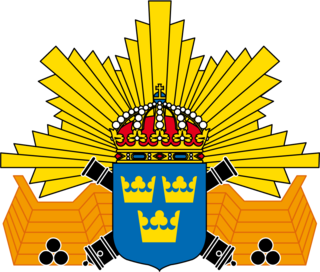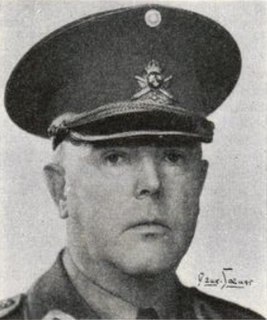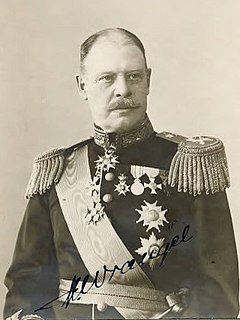This article contains translated text and the factual accuracy of the translation should be checked by someone fluent in Swedish and English. |
Henrich Danckwardt (circa 1670 - 16 September 1719), was a Swedish military officer.
This article contains translated text and the factual accuracy of the translation should be checked by someone fluent in Swedish and English. |
Henrich Danckwardt (circa 1670 - 16 September 1719), was a Swedish military officer.
Danckwardt was born to Henrik Danckwardt and Elisabet Clerck, and was the grandson of Joachim Danckwardt. He served for 9 years as a page under queen consort Hedvig Eleonora. Danckwardt was named fänrik of the Västgöta-Dal Regiment in 1697 under Major Hugo Hamilton. Hamilton, during his previous service at another regiment, had then personally requested Danckwardt to be his captain. Hamilton was also responsible for Danckwardt's promotions to Major in 1711, and to Överstelöjtnant (Lieutenant colonel) in 1712. [1]
After the debacle at Poltava, Hamilton's regiment was moved from Stockholm to Malmö, where it participated in the Battle of Helsingborg in 1710. In 1712, it moved to Gothenburg.
Danckwardt was promoted to Colonel and commander of Carlsten fortress at Marstrand in 1712. When Carlsten was assaulted by Peder Tordenskjold's forces, Danckwardt was forced to surrender on 15 July 1719. Danckwardt was thereafter arrested while trying to evade custody, and sentenced to death.
The executioner was at the time, intoxicated and was therefore delayed. When the executioner at last arrived, he had to attempt the decapitation of Danckwardt twice before succeeding on 16 September 1719 in Gothenburg. The executioner received a formal warning.
Danckwardt's fellow officers were also later sentenced by the court martial to the death penalty, but were pardoned.

Anders Örbom was a captain in the Swedish Army who was at the Surrender at Perevolochna and taken to Siberia as a prisoner of war for 13 years.

The Swedish Coastal Artillery has its origin in the Archipelago Artillery that was raised in 1866. The Coastal Artillery was formed from the Archipelago Artillery, the Marine Regiment and parts of the Artillery in 1902. Kustartilleriet, abbreviated KA, was an independent branch within the Swedish Navy until July 1, 2000, when the Swedish Coastal Artillery was disbanded and reorganised as the Swedish Amphibious Corps. The changed name and new structure were to reflect the new tasks that the old Coastal Artillery had moved to after the end of the Cold War and the demise of the Warsaw Pact.

The Artillery Regiment, designated A 9, is the only artillery regiment in the Swedish Armed Forces. The regiment was formed by bringing together all the artillery regiments of the Swedish Army, and it took its designation A 9 from the Bergslagen Artillery Regiment. The regiment carries the battle honours of all past Swedish artillery regiments. Its new organisation was founded in 2000 in Kristinehamn and in 2005 the regiment was moved to Boden.

Västmanland Wing, also F 1 Hässlö, or simply F 1, is a former Swedish Air Force wing with the main base located at Hässlö Airport in Västerås in central Sweden.

Bertil Gustafsson Uggla was a Swedish officer, track and field athlete, modern pentathlete, and fencer.

South Scanian Regiment, designation P 7, is a Swedish Army armoured regiment that traces its origins back to 1811. It was converted from an infantry regiment in 1963 and renamed from South Scania Infantry Regiment. The regiment's soldiers were originally recruited from the region of Scania (Skåne), and it is currently garrisoned in Revingehed outside Lund, in Skåne County.

The Air Defence Regiment, is the only anti-aircraft regiment in the Swedish Armed Forces. Its new organisation was introduced in 2000, when all other anti-aircraft units in Sweden were disbanded. The regiment is located in Halmstad and has the responsibility for training two air defence battalions and one home guard battalion.

The Attack on Marstrand was a successful Dano-Norwegian siege of the Swedish town of Marstrand and Carlsten fortress which took place between July 10 and July 16, 1719 during the end of the Great Northern War.

The battles at Göta älv were a series of battles and sieges which took place in and around the Gothenburg area between 1717 and 1719, between the Swedish Empire and Denmark-Norway, during the Great Northern War.
Master-General of the Ordnance was in Sweden a chief officer of the Krigskollegium from 1682 to 1865, then until 1968 in the Royal Swedish Army Materiel Administration.

Swedish Armoured Troops School was a school of the Swedish Armoured Troops in the Swedish Army which operated in various forms the years 1944–1981. The school was located in Skövde Garrison in Skövde.

1st Marine Regiment is an amphibian regiment of the Swedish Amphibious Corps based at the Berga Naval Base in Berga, Haninge Municipality. Raised from the Vaxholm Coastal Artillery Regiment in 2000 when the Swedish Amphibious Corps was formed, the 1st Marine Regiment has a large geographical spread where units are trained and grouped at Berga, south of Stockholm, in Gothenburg and in Gotland. Although the unit's natural combat environment is coastal zones, river deltas and other amphibious areas, the unit has the ability to operate in all types of terrain, such as desert. The 1st Marine Regiment has participated in operations in, for example, Kosovo, Gulf of Aden, Chad and Afghanistan.

4th Marine Regiment was an amphibian regiment of the Swedish Amphibious Corps based in Gothenburg. Raised from Älvsborg Coastal Artillery Regiment in 2000 when the Swedish Amphibious Corps was formed, the 4th Marine Regiment only operated for four years before being disbanded in 2004.

Swedish Armed Forces Centre for Defence Medicine is a tri-service military medicine center in the Swedish Armed Forces. Its staff is made up of officers, civilian specialists, group commanders and officer reservists – tasked with ensuring care is provided during peacetime, on international missions, at times of crisis and in combat.

The Älvsborg Coastal Artillery Regiment, designation KA 4, was a Swedish Navy coastal artillery regiment of the Swedish Armed Forces which operated between 1942 and 2000. The unit was based in Gothenburg.

Lieutenant General Karl Rudolf Kolmodin was a Swedish Coastal Artillery officer. Kolmodin's senior commands include postings as commanding officer of the Gothenburg Coastal Artillery Defence and Stockholm Coastal Artillery Defence and as Inspector of the Swedish Coastal Artillery.
Lieutenant General Lars Göran Persson was a Swedish Coastal Artillery officer. Persson was Chief of the Naval Staff from 1987 to 1994 and Chief of Staff and Military Commander of the Northern Military District from 1996 to 1998.

Lieutenant General Karl Birger Hedqvist was a Swedish Army officer. He served as Deputy Chief of Ordnance from 1939 to 1949 and as Master-General of the Ordnance from 1949 to 1959.

Lieutenant General Herman Georg Waldemar Wrangel was a senior officer in the Swedish Coastal Artillery. He served as commanding officer of the Swedish Coastal Artillery for 15 years (1909–1924). Wrangel served as secretary, member and chairman of a number of committees and commissions. Wrangel was also a member of the Upper House of the Riksdag and a member of the Committee on Defence as well as of the Committee of Supply.
Lieutenant General Nils Gustaf Axel Welin was a senior Swedish Army officer. Welin served as head of the Swedish National Defence College (1984–1987), as Force Commander of the United Nations Disengagement Observer Force (UNDOF) (1986–1988) and as Commanding General of the Southern Military District (1988–1992).